Recent Water Damage Posts
Tips to Protecting Your Remote-Based Business
10/17/2023 (Permalink)
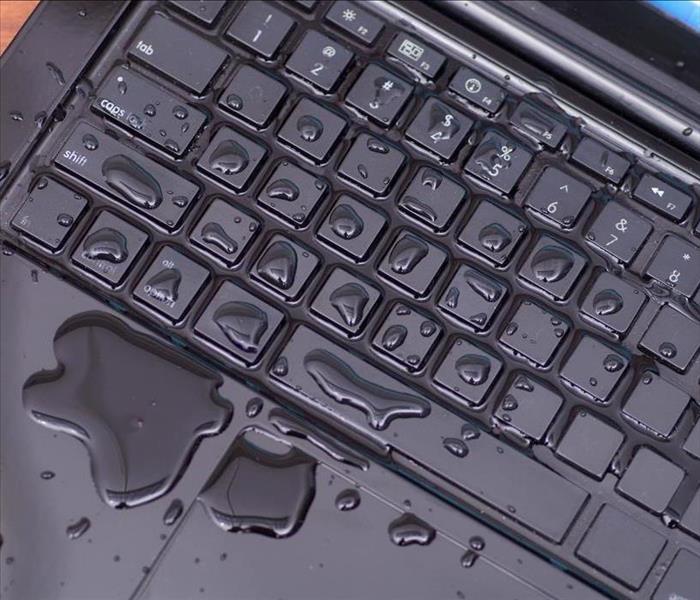 In this blog we provide some steps you can take to prepare for water damage and mitigate its impact on your work-from-home business.
In this blog we provide some steps you can take to prepare for water damage and mitigate its impact on your work-from-home business.
As the number of work-from-home businesses continues to grow, it's important to consider water damage preparedness. Water damage can cause significant disruption to a home-based business, resulting in property damage, loss of inventory, and loss of income. In this blog post, we will discuss some steps you can take to prepare for water damage and mitigate its impact on your home-based business.
Conduct Regular Risk Assessment
One of the first steps in water damage preparedness is to identify the risks that may affect your business. Conducting a risk assessment can help you identify potential sources of water damage, such as leaking pipes, poor drainage, and natural disasters. Make a list of these risks and prioritize them based on their likelihood and potential impact.
Regularly Inspect Your Property
Regular property inspections can help detect issues early, reducing the risk of significant water damage. Inspect your property regularly for signs of water damage, such as leaks, water stains, and mold growth. Address any issues promptly to prevent further damage.
Back up all your important business documents, files, and data regularly. This will reduce the risk of losing valuable information in case of water damage. Use cloud-based storage or an external hard drive to store your important files.
Consider Business Interruption Insurance
Business interruption insurance can help cover the loss of income and expenses suffered due to water damage. Consider purchasing this insurance to protect your business in case of significant damage.
Create a Water Damage Emergency Plan
Develop a plan of action to follow in case of water damage. This plan should include steps to take in case of an emergency, contact information for emergency responders, and a plan for evacuating important equipment and inventory.
Investing in flood preparedness equipment such as sandbags, flood barriers, and sump pumps can help minimize the impact of water damage. Determine which equipment will best suit your business's needs and ensure it is readily available.
Contact Professional Water Damage Restoration Services
In case of significant water damage, it's crucial to contact professional water damage restoration services. They have specialized equipment and expertise to assess the damage, mitigate further damage, and restore your property promptly.
In conclusion, water damage can cause significant disruption to work-from-home businesses, but with preparedness and proactive measures, you can protect your business from potential financial losses and significant damages. Conducting regular assessments, and inspections, and investing in flood preparedness equipment can minimize the risk of water damage. Always keep in mind that prompt response and professional help in case of significant water damage can help mitigate further damage and save your business.
A Step-by-Step Guide: What to Do If Your Refrigerator Leaks
7/14/2023 (Permalink)
Discovering a leak from your refrigerator can be a cause for concern. Not only can it lead to water damage in your kitchen or surrounding areas, but it can also indicate an underlying issue that needs to be addressed promptly. In this blog post, we will provide you with a step-by-step guide on what to do if your refrigerator leaks. By following these steps, you can mitigate the damage, ensure the safety of your home, and potentially avoid costly repairs.
Safety First
When you notice a refrigerator leak, it's crucial to prioritize safety. Turn off the power supply to the refrigerator by unplugging it from the electrical outlet. This step will prevent any potential electrical hazards and reduce the risk of injury.
Locate the Source of the Leak
Identifying the source of the leak is the next important step. Start by inspecting the area around the refrigerator to determine the origin of the water. Common sources of leaks include:
Water supply line: If your refrigerator has a water dispenser or ice maker, check the water supply line connections at the back of the refrigerator for any signs of leakage or disconnection.
Defrost drain line: A clogged or damaged defrost drain line can cause water to accumulate and leak from the refrigerator. Check for any blockages or obstructions in the drain line.
Condensation: In humid climates or during hot weather, condensation can form on the exterior of the refrigerator and drip onto the floor. Ensure the leak is not simply condensation before proceeding with further steps.
Clear Blockages or Obstructions
If the leak is originating from the defrost drain line, it may be due to a blockage. Use a turkey baster or a small funnel to flush warm water through the drain line, clearing any debris or ice buildup that may be causing the blockage. This step can help restore proper drainage and prevent future leaks.
Check and Tighten Connections
If the leak is originating from the water supply line, inspect the connections at the back of the refrigerator and the water source. Ensure that all connections are secure and tightened properly. If you notice any damaged or worn-out parts, such as cracked or kinked water supply lines, they may need to be replaced.
Clean and Dry the Area
Once you have addressed the source of the leak, clean up any water that has accumulated around the refrigerator. Use absorbent towels or a mop to soak up the water and ensure the area is thoroughly dried. This step is crucial in preventing further water damage and the growth of mold or mildew.
Monitor for Recurring Leaks
After completing the necessary steps, keep an eye on your refrigerator to ensure that the leak has been resolved. If the leak persists or recurs, it may be an indication of a more significant issue. In such cases, it is recommended to contact a professional appliance repair service to diagnose and address the problem.
Discovering a leak from your refrigerator can be a cause for concern, but by following these steps, you can effectively address the issue and prevent further damage. Remember to prioritize safety, identify the source of the leak, clear any blockages, and check and tighten connections. Clean and dry the area thoroughly, and monitor for recurring leaks. If you're unable to resolve the issue on your own, don't hesitate to seek the assistance of a professional appliance repair service. By taking swift action, you can safeguard your home, protect your belongings, and ensure the proper functioning of your refrigerator.
Who To Call After A Water Damage Event Occurs
3/18/2023 (Permalink)
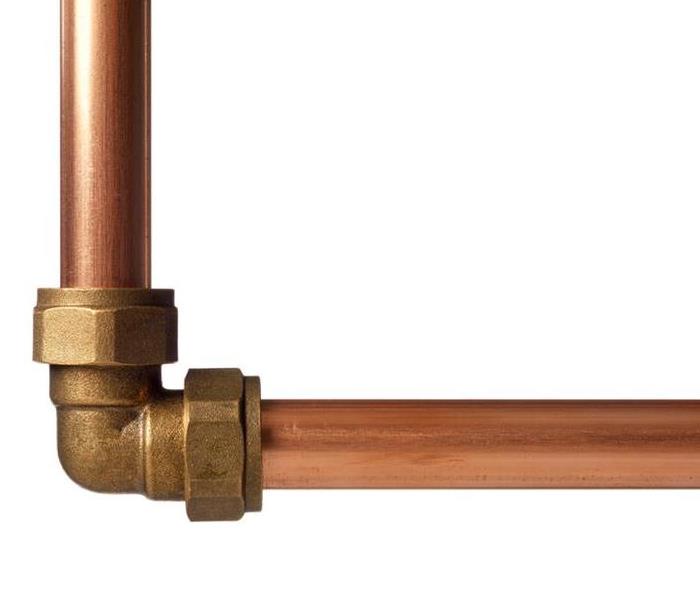 When water damage occurs, give SERVPRO a call!
When water damage occurs, give SERVPRO a call!
Water damage can be a scary situation to deal with. Whether your home or business has been flooded by a burst pipe, a storm caused flooding in your home, or your toilet clogged and overflowed...the resulting damage can be devastating. You don't have to panic though! Just follow these simple steps and you'll be back on track in no time.
Who to Call After Water Damage
Water damage can be stressful, but knowing who to call after water damage occurs can make all the difference in the world.
If you have homeowners insurance, call your insurance company first. They'll direct you on what steps need to be taken next and how they will handle any expenses related to removing moisture from your home or business.
Your next call should be to a water damage restoration company. This is the company that will actually clean and restore your property after a water loss. They will make sure that everything is being taken care of properly by trained professionals.
Insurance Company
If you are insured, the first thing you should do is contact your insurance company. They will tell you if there is coverage for water damage in your home or business and what steps to take next. Once they have determined that the damage is covered by an insurance policy, they will send a claims adjuster out to assess the situation and determine how much money it will cost to fix it.
Water Damage Restoration Company
Water damage restoration companies are experts in the field of water damage restoration. They have years of experience and training, and they know exactly what to do when your home or business suffers from this kind of damage.
They can help you with the entire process, from water removal to cleaning to repairs--saving you time and money. Most companies, such as SERVPRO, will also work with your insurance company to process your claim, ensuring that they receive the proper documentation and repair estimates. They will take care of the claims process for you from start to finish.
Why SERVPRO?
SERVPRO of South Baton Rouge is the leading provider of fire and water damage restoration services in Baton Rouge, LA. Our highly trained technicians respond quickly to your emergency, performing a thorough inspection and damage assessment, followed by water removal, drying, and restoration.
We are dedicated to restoring your property back to preloss condition as quickly as possible while being respectful of you and your family's needs during this stressful time. Our goal is to help families get their lives back on track by returning them back to their homes or businesses with minimal impact on daily routine activities.
It's important to know who to call if a water damage situation occurs in your home or business. It's also important that you choose the right company for the job! SERVPRO of South Baton Rouge is always on standby and ready to respond to your water damage emergency.
How To Flush a Water Heater?
11/15/2022 (Permalink)
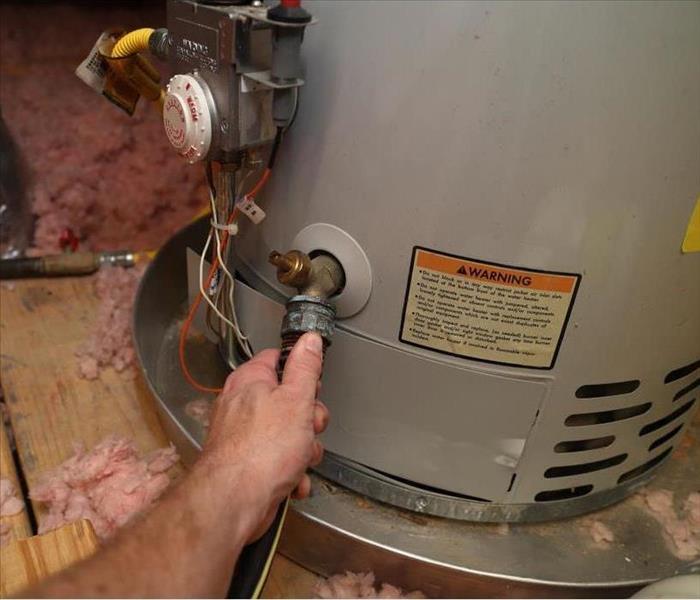 Flushing your water heater is a simple procedure that you can perform yourself
Flushing your water heater is a simple procedure that you can perform yourself
How Should a Water Heater Be Flushed?
If you've ever come home and found your water heater leaking, it's likely because something went wrong with the tank. Water heaters are designed to last for years, but they're not immune to problems. A clogged drain line can cause a tank to overflow or leak into your basement. If there's sediment buildup in either the tank or piping (or both), those components will eventually stop working properly due to rusting and mineral deposits that cause corrosion. How do you flush out all that crud? Follow these steps:
Turn off the water and power
Whether you're an experienced DIYer or hiring a professional, it's important to turn off the water and power to your water heater before beginning any work. If you don't know how to do this, enlisting the help of someone who does is always a good idea.
Drain the water heater
If you've never done this before, it can be a little intimidating. But it's actually pretty easy to drain the water heater. All you have to do is find the drain valve (it'll be on the bottom of your water heater) and use a hose to drain out all of that old water.
Attach a hose to the drain valve
Once you've found the drain valve, attach a hose to it using a garden hose. Make sure that the other end of the hose goes somewhere safe: either outside or down a hole where it won't get clogged with dirt.
Open the drain valve
Flushing a water heater is much like flushing any other plumbing fixture in that you need to open the drain valve and then use some sort of hose or faucet to drain the tank. That said, some water heaters don't have a drain valve, so it's important to know how your system works ahead of time. This will effectively flush out most remaining sediment particles.
- Use a plunger
- Remove the fill cap and pour water into the tank until it's full again
Close the drain valve and refill the tank
Make sure to close the drain valve before turning on the power and water again. If you don't close it, your water heater will not be able to refill. Once the water is on, your heater will begin to refill with water. This process can take hours, so be patient!
How often should I flush my water heater?
Flushing your water heater is a simple procedure that you can perform yourself. It's important to flush your water heater regularly, as the buildup of rust and sediment can lead to breakdowns and prevent it from working properly.
The frequency with which you should flush your hot water tank depends on many factors, such as how much sediment is present in your water supply, what kind of filters are installed on the tank (if any), and how old/new the unit is. As a general rule: if you have hard water that hasn't been treated yet or if there are no filters installed on your hot-water tank then flushing should be done every 6 months; otherwise, flushing should be done once per year.
Hopefully, this article has helped you understand how to flush your water heater. If you're still unsure about what to do with your tank, contact a professional plumber. They'll know exactly how much water you need to drain and will have all the necessary tools for cleaning and flushing.
3 Reasons Protecting Wood From Water Is Vital To Its Lifespan
7/30/2022 (Permalink)
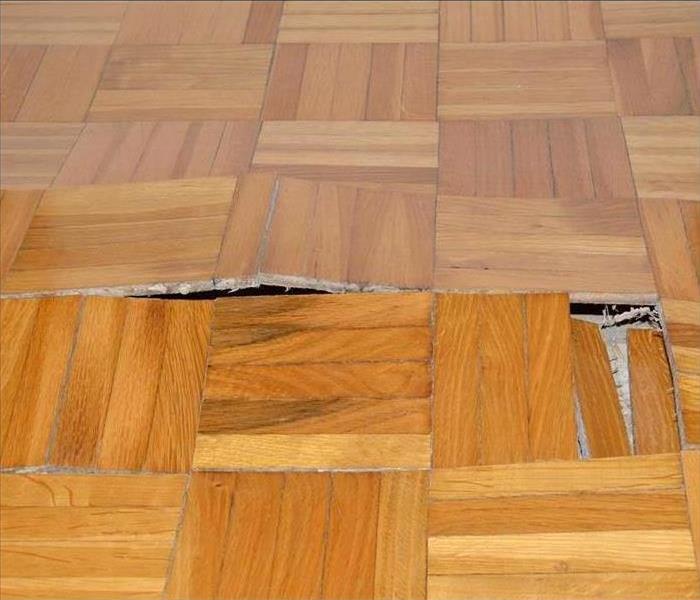 Wooden floor damaged by water.
Wooden floor damaged by water.
Three Reasons To Protect Wood From Water
One of the biggest threats to the longevity of wood is water. Wood continuously absorbs and expels water, a process that eventually degrades the integrity of the material to the point that it is no longer usable. Especially in humid and rainy regions, swelling wood can be a persistent problem that is of utmost importance to address to extend the life of wooden constructions.
1. Contraction and Expansion Damages Wood
Swelling and shrinkage in wood are driven by moisture. Years of water absorption and expulsion weaken the integrity of the fibrous cell walls that make the material rigid. This leads to fragility and cracking, which not only causes breakage but increases the likelihood of decay. Minimizing the amount of water absorbed is key to prolonging the life of wood, making it vital to keep it sealed with paint or finishes like urethane.
2. Variation in Swelling Wood Rates Affect the Integrity of Structures
The speed of swelling and shrinking varies in each individual piece of wood. Uneven rates of swelling or shrinking can not only cause distortion or warping in an individual chunk but can also cause joint problems in the frame of a house or a piece of furniture. Protecting wood with paint or finish thus helps slow the distortion at the joints, increasing the longevity of wooden structures.
3. Keeping It Dry Is Protection, Too
Interior wood (studs, joists, etc.), although not exposed to the elements and hence often left unprotected, still requires vigilant upkeep. Exposure to water from a ruptured supply line or a leak from a water pipe repair can lead to swelling problems if left unaddressed. The life of even this unprotected wood can be prolonged simply by ensuring that any damp parts are allowed to dry and are kept dry.
In most cases, the effects of swelling wood can be mitigated by keeping a watchful eye on the paint or finish that protects it. Hiring the services of protection and restoration professionals is also a good way to ensure that homeowners in Baton Rouge, LA, get the most out of their wood.
Common Reasons Your Toilet Leaks When You Flush
5/20/2022 (Permalink)
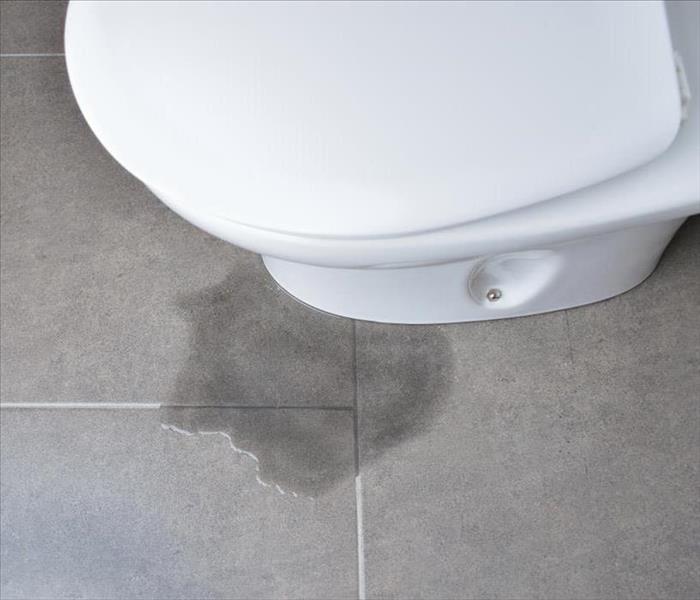 Toilet leaking in Gardere, LA.
Toilet leaking in Gardere, LA.
The Most Common Causes of Toilet Leaks When You Flush
Toilets are a common source of household floods in Gardere, LA. Understanding what causes a leaking toilet can prevent water damage and help you decide if you need to replace your unit. These common culprits are responsible for leaks every time you flush.
Damaged Tank Flange
The flange pipe passes through the floor, secures the toilet, carries waste to the sewer and seals in odors. A rocking toilet and leaks upon flushing are indications of flange problem with symptoms, including:
- A soft floor near the toilet's base
- Water spots on the ceiling beneath the toilet
- Uneven flooring beneath the toilet
Damaged Flapper
The flapper is a rubber or plastic part that rests over the flush valve. It helps keep water inside the tank and lifts it to release it into the bowl upon flushing. Flapper damage causes water to continue flowing into the bowl after flushing and may cause flooding.
Dry Wax Ring
The wax seal between the toilet and the drain pipe requires replacement when it dries out, contracts and allows water to seep out during flushing. Signs of a leaking toilet due to an ineffective wax ring are an accumulation of water at the toilet's base and water stains on the ceiling below it.
Cracks in the Bowl
Trauma and excessive use can cause a toilet's porcelain to crack and leak with every flush. Cracks inside the bowl can cause a damaging bathroom leak. Therefore, replacement of the entire toilet is usually necessary.
Loose Tank
A loose connection between the tank and base of two-part toilets can cause a leak upon flushing. Tightening the bolts that attach these parts or replacing the rubber seal between them usually fixes the problem.
Improper Installation Can Also Cause a Leaking Toilet
Floods and leaks due to appliance and fixture installation errors are common causes of household water damage that emergency flood services address. Therefore, it is essential to carefully execute each step of the toilet installation process.
If you suspect a leak at your home in Gardere, LA, addressing it quickly can prevent water damage throughout your home.
Prevent Plumbing Disasters by Staying Proactive
3/1/2022 (Permalink)
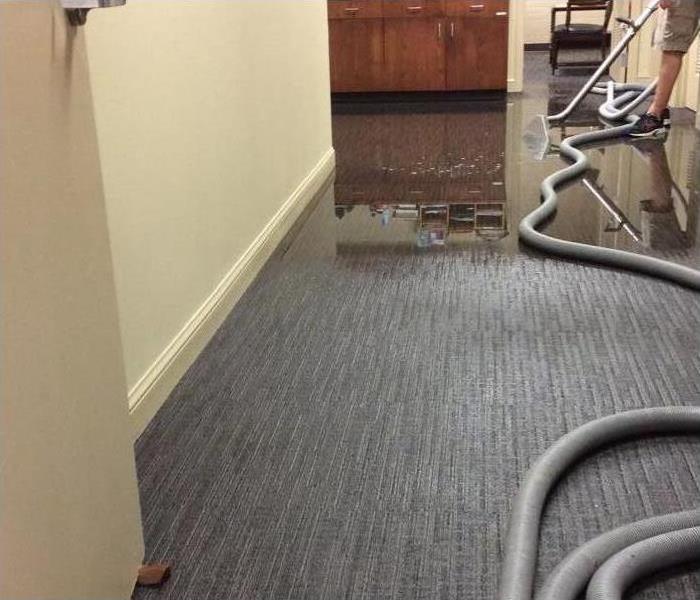 Commercial water damage in Gardere, LA.
Commercial water damage in Gardere, LA.
Four Ways To Prevent Plumbing Disasters
Being proactive when it comes to plumbing problems is a great way to prevent disasters and extend the life of your business’s plumbing system. Conversely, ignoring minor signs and waiting for disaster to strike can lead to costly repairs and additional damage. If you want to save money, and perhaps save your sanity, learning how to stay ahead of your plumbing issues is especially important in Gardere, LA.
1. Find a Professional Plumber
Even before you become aware of any potential issues, it is a good idea to get the contact information of a reliable plumbing service. Knowing who to call in the event of a broken pipe or similar emergency can save you from the headache of scrambling to find one later when the need is urgent. It is also recommended to have the number of a commercial water cleanup service available, in the event of an unforeseen water disaster.
2. Schedule Routine Inspection and Maintenance
Routine maintenance is important for ensuring your plumbing system is working properly. Plumbers will advise you on proactive measures, such as upgrading old equipment that is no longer reliable. Upgrading can save you money in the long run by helping you avoid leaks and other damage.
3. Fix Small Problems
Take care of minor plumbing problems like dripping faucets and slow draining sinks before they morph into expensive issues. Dripping faucets may not seem like a big deal, but they can run up your water bill over time.
4. Watch Your Monthly Usage
Keeping an eye on your monthly water bill can help you spot problems that go unnoticed to the naked eye. If your bill skyrockets without any explanation, you could have an underlying problem, such as a faulty pipe behind your walls or a major leak in your water main.
Being proactive is one of the most effective ways to ensure you catch plumbing problems in your building before they start. Investing the time and money to maintain a good working system will far outweigh the cost of major repairs down the road.
Cleaning After a Flood
1/10/2022 (Permalink)
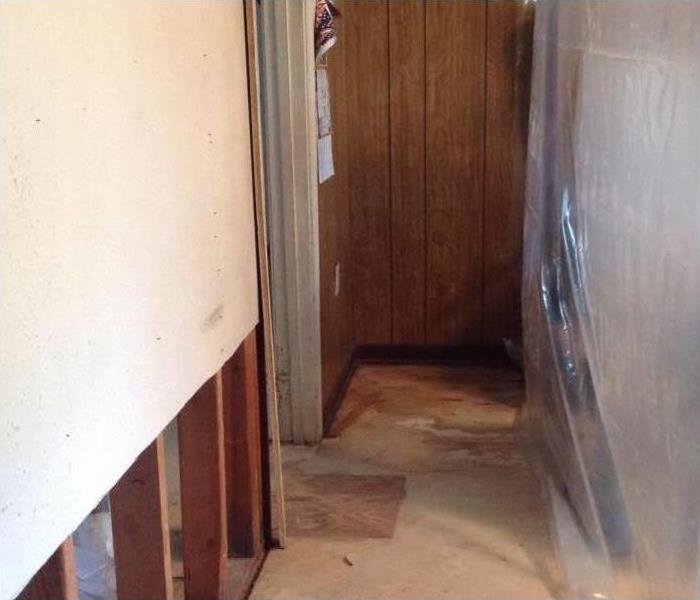 Water in your home requires a lot of work.
Water in your home requires a lot of work.
Cleaning After a Flood
When floodwater in the home is gone, and most of the heavy work is finished, many Gardere, LA, families and individuals want to slip back into life as they knew it before the disaster. Unfortunately, all the wood, fabric, drywall, and other materials exposed to the water have probably absorbed the liquid. Moving belongings back into your house too soon could lead to ongoing problems, such as mold growth, pest infestations, and long-term deterioration. Remember, flood water isn't clean; it needs to be handled differently than other types of water disasters, such as a broken pipe.
Focus on Safety
Before taking your first recovery steps, make sure you know how to proceed safely.
• Arrange structural, electrical, fire, and gas inspections, so you know the home is safe to enter.
• Wear sturdy, protective clothing. It's best to have waterproof protection.
• Don't mix chemicals, such as chorine and ammonia, when cleaning.
• Watch out for pests hiding in flooding, including snakes and fire ants.
If you're not sure about safety and water in the home, get more information from water damage remediation professionals and local authorities.
Contact Appropriate Professionals
Your next steps should include contacting your insurance adjuster, scheduling repairs and cleaning from professionals in Gardere, LA, and making sure your electricity and gas have been turned off. With these tasks completed, move on to cleaning and disinfecting your property.
Identify the Work
Working closely with the remediation professionals, you'll separate items into at least three categories: to clean yourself, to leave for the technicians, and to discard. There are many repairs you can handle yourself. Clothing may be wet or could have a mildew smell. It's generally safe for laundering or dry cleaning those items on your own. However, expensive and structural items should be turned over to professionals. Your carpets, flooring, furniture, and walls present cleaning challenges that require specialized techniques and training. Finally, some items, such as mattresses, must be thrown out for your family's health.
Water in your home requires a lot of work even after floods recede. When you know what to do and who to call for help, that work can progress smoothly and efficiently.
 In this blog we provide some steps you can take to prepare for water damage and mitigate its impact on your work-from-home business.
In this blog we provide some steps you can take to prepare for water damage and mitigate its impact on your work-from-home business.



 24/7 Emergency Service
24/7 Emergency Service





